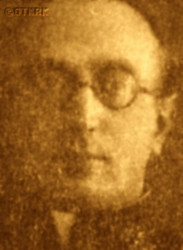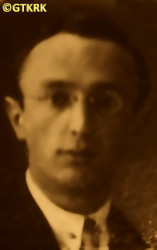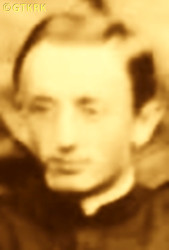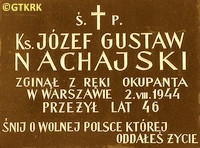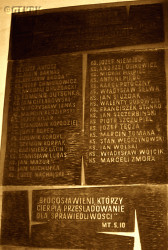Roman Catholic
St Sigismund parish
05-507 Słomczyn
85 Wiślana Str.
Konstancin deanery
Warsaw archdiocese, Poland
full list:
displayClick to display full list

searchClick to search full list by categories
wyświetlKliknij by wyświetlić pełną listę po polsku

szukajKliknij by przeszukać listę wg kategorii po polsku

Martyrology of the clergy — Poland
XX century (1914 – 1989)
personal data
surname
NACHAJSKI
surname
versions/aliases
BĄK
forename(s)
Joseph Gustav (pl. Józef Gustaw)
function
diocesan priest
creed
Latin (Roman Catholic) Church RCmore on
en.wikipedia.org
[access: 2014.09.21]
diocese / province
Przemyśl diocesemore on
www.przemyska.pl
[access: 2013.02.15]
RC Military Ordinariate of Polandmore on
en.wikipedia.org
[access: 2014.12.20]
honorary titles
„Cross of Valour”more on
„Cross of Valour”
(24.07.1921, twice)
„Eaglets” commemorative badgemore on
„Eaglets” commemorative badge
(19.03.1919)
date and place
of death
02.08.1944

Warsawtoday: Warsaw city pov., Masovia voiv., Poland
more on
en.wikipedia.org
[access: 2021.10.09]
details of death
As a cleric took part, in the ranks of the Polish Army of Eastern Galicia, known as Army „East”, in the Polish–Ukrainian war of 1918‐1919, in particular in the fights to defend Lviv attacked by the Ukrainians — the siege was lifted in 03.1919. Next prob. a soldier of the 1st Legion Infantry Regiment, as part of the 1st Legion Infantry Division. The Regiment took part in the Polish–Russian War of 1919‐1921, among others in the liberation of Vilnius in 1919, in the battles in the Vilnius region and Belarus in 1919, together with Latvian troops in the victorious Battle of Daugavpils in early 1920, in the expedition to Kiev in 05‐06.1920, during the retreat in skirmishes with the troops of the attacking Russian 1st Cavalry Army under the command of Semyon Budyonny. Finally, took part in the Battle of Warsaw (known as the „Miracle on the Vistula”), when Polish troops defeated the invading Russian forces on c. 15.08.1920 — contributed to the liberation from the Russian hands of Drohiczyn, Białystok on 22.08.1920 during the Battle of Białystok, and finally Lida.
In 1927 and 1929 appointed reserve chaplain of the Polish Army (first time by order of the President of the Republic of Poland of 01.09.1927, with seniority from 01.01.1927 and 166th place among the Roman Catholic military clergy; each time for a statutory 2‐year period).
After German and Russian invasion of Poland in 09.1939 and start of the World War II, during German occupation of Poland, served as vice–president of the board of the Rzeszów district of the underground National Party.
Wanted by German Germ. Geheime Staatspolizei (Eng. Secret State Police), i.e. Gestapo, went into hiding in Warsaw.
Became a representative of the Department of the Organizing Board of the National Party and National Military Organization (part of Polish Clandestine State) in Warsaw.
Murdered by Germans during Warsaw Uprising, prob. executed on Narutowicza Sq. in Warsaw.
cause of death
mass murder
perpetrators
Germans
sites and events
Warsaw UprisingClick to display the description, GeneralgouvernementClick to display the description, Ribbentrop‐MolotovClick to display the description, Pius XI's encyclicalsClick to display the description
date and place
of birth
13.08.1898Birth certification on:
metryki.genbaza.pl
[access: 2025.08.19]

Ulanówtoday: Ulanów gm., Nisko pov., Subcarpathia voiv., Poland
more on
en.wikipedia.org
[access: 2020.11.27]
parents
BĄK Anthony
🞲 ?, ? — 🕆 ?, ?

NACHAJSKA Caroline
🞲 ?, ? — 🕆 ?, ?
baptism
21.08.1898Birth certification on:
metryki.genbaza.pl
[access: 2025.08.19]

Ulanówtoday: Ulanów gm., Nisko pov., Subcarpathia voiv., Poland
more on
en.wikipedia.org
[access: 2020.11.27]
St Barbara and St Joseph Spouse of the Blessed Virgin Mary RC church
presbyter (holy orders)
ordination
22.05.1921

Przemyśltoday: Przemyśl city pov., Subcarpathia voiv., Poland
more on
en.wikipedia.org
[access: 2021.04.01]
Assumption of the Blessed Virgin Mary and St John the Baptist RC cathedral churchmore on
en.wikipedia.org
[access: 2025.03.14]
positions held
1932 – c. 1939
prefect — Jawornik Polskitoday: Jawornik Polski gm., Przeworsk pov., Subcarpathia voiv., Poland
more on
en.wikipedia.org
[access: 2021.10.09] ⋄ St Andrew the Apostle RC parish ⋄ Dynówtoday: Dynów urban gm., Rzeszów pov., Subcarpathia voiv., Poland
more on
en.wikipedia.org
[access: 2021.10.09] RC deanery — public primary schools in Jawornik Polski, Hadle Szklarskie, Hucisko Jawornickie i Widaczów
vice president — Rzeszówtoday: Rzeszów city pov., Subcarpathia voiv., Poland
more on
en.wikipedia.org
[access: 2021.06.07] ⋄ District Board, National Party
1928 – 1932
prefect — Niskotoday: Nisko gm., Nisko pov., Subcarpathia voiv., Poland
more on
en.wikipedia.org
[access: 2021.10.09] ⋄ State Gymnasium ⋄ St Joseph Spouse of the Blessed Virgin Mary RC parish ⋄ Rudnik nad Sanemtoday: Rudnik nad Sanem gm., Nisko pov., Subcarpathia voiv., Poland
more on
en.wikipedia.org
[access: 2021.10.09] RC deanery
c. 1925 – 1928
prefect — Tarnobrzegtoday: Tarnobrzeg city pov., Subcarpathia voiv., Poland
more on
en.wikipedia.org
[access: 2021.10.09] ⋄ Private Teachers' Seminary for Women ⋄ Assumption of the Blessed Virgin Mary RC parish ⋄ Miechocintoday: district of Tarrnobrzeg, Tarnobrzeg city pov., Subcarpathia voiv., Poland
more on
en.wikipedia.org
[access: 2021.10.09] RC deanery
c. 1924
vicar — Miechocintoday: district of Tarrnobrzeg, Tarnobrzeg city pov., Subcarpathia voiv., Poland
more on
en.wikipedia.org
[access: 2021.10.09] ⋄ St Mary Magdalene RC parish ⋄ Miechocintoday: district of Tarrnobrzeg, Tarnobrzeg city pov., Subcarpathia voiv., Poland
more on
en.wikipedia.org
[access: 2021.10.09] RC deanery
1922 – 1924
vicar — Spietoday: part of Wilcza Wola, Dzikowiec gm., Kolbuszowa pov., Subcarpathia voiv., Poland
more on
en.wikipedia.org
[access: 2021.10.09] ⋄ St Michael the Archangel RC church ⋄ Raniżówtoday: Raniżów gm., Kolbuszowa pov., Subcarpathia voiv., Poland
more on
en.wikipedia.org
[access: 2021.10.09], Assumption of the Blessed Virgin Mary RC parish ⋄ Głogów Małopolskiform.: Głogów
today: Głogów Małopolski gm., Rzeszów pov., Subcarpathia voiv., Poland
more on
en.wikipedia.org
[access: 2010.08.11] RC deanery
c. 1922
student — Lvivtoday: Lviv urban hrom., Lviv rai., Lviv obl., Ukraine
more on
en.wikipedia.org
[access: 2022.01.16] ⋄ Department of Law, John Casimir University [i.e. clandestine John Casimir University (1941‐1944) / Ivan Franko University (1940‐1941) / John Casimir University (1919‐1939) / Franciscan University (1817‐1918)]
1921 – 1922
vicar — Sieniawatoday: Sieniawa gm., Przeworsk pov., Subcarpathia voiv., Poland
more on
en.wikipedia.org
[access: 2021.10.09] ⋄ St John the Baptist RC parish ⋄ Jarosławtoday: Jarosław gm., Jarosław pov., Subcarpathia voiv., Poland
more on
en.wikipedia.org
[access: 2021.04.01] RC deanery
till 1921
student — Przemyśltoday: Przemyśl city pov., Subcarpathia voiv., Poland
more on
en.wikipedia.org
[access: 2021.04.01] ⋄ philosophy and theology, Theological Seminary
sites and events
descriptions
Warsaw Uprising: Lasted from 01.08.1944 till 03.10.1944. Was an attempt to liberate Polish capital from occupying Germans by the Polish Clandestine State — a unique in the history of the world political structure on the territories occupied by the Germans, effectively governing clandestinely in Poland — and by fighting on its behalf underground military units, mainly of Home Army (former Armed Struggle Association ZWZ) and National Armed Forced (NSZ). At the same time Russians stopped on purpose the offensive on all front, halted on the other bank of Vistula river and watched calmly the annihilation of the city, refusing even the mid‐landing rights to the Allied planes carrying weapons and supplies to the insurgents from Italy. During the Uprising Germans murdered approx. 200,000 Poles, mainly civilians. Approx. 200 priests and nuns died in fighting or were murdered by the Germans, many in mass executions. (more on: en.wikipedia.orgClick to attempt to display webpage
[access: 2013.08.17])
Generalgouvernement: After the Polish defeat in the 09.1939 campaign, which was the result of the Ribbentrop‐Molotov Pact and constituted the first stage of World War II, and the beginning of German occupation in part of Poland (in the other, eastern part of Poland, the Russian occupation began), the Germans divided the occupied Polish territory into five main regions. In two of them new German provinces were created, two other were incorporated into other provinces. However, the fifth part was treated separately, and in a political sense it was supposed to recreate the German idea from 1915 (during World War I, after the defeat of the Russians in the Battle of Gorlice in 05.1915) of creating a Polish enclave within Germany. Illegal in the sense of international law, i.e. Hague Convention, and public law, managed by the Germans according to separate laws — especially established for the Polish Germ. Untermenschen (Eng. subhumans) — till the Russian offensive in 1945 it constituted part of the Germ. Großdeutschland (Eng. Greater Germany). Till 31.07.1940 formally called Germ. Generalgouvernement für die besetzten polnischen Gebiete (Eng. General Government for the occupied Polish lands) — later simply Germ. Generalgouvernement (Eng. General Governorate), as in the years 1915‐1918. From 07.1941, i.e. after the German attack on 22.06.1941 against the erstwhile ally, the Russians, it also included the Galicia district, i.e. the Polish pre‐war south‐eastern voivodeships. A special criminal law was enacted and applied to Poles and Jews, allowing for the arbitrary administration of the death penalty regardless of the age of the „perpetrator”, and sanctioning the use of collective responsibility. After the end of the military conflict of the World War UU, the government of the Germ. Generalgouvernement was recognized as a criminal organization, and its leader, governor Hans Frank, guilty of war crimes and crimes against humanity and executed. (more on: en.wikipedia.orgClick to attempt to display webpage
[access: 2024.12.13])
Ribbentrop‐Molotov: Genocidal Russian‐German alliance pact between Russian leader Joseph Stalin and German leader Adolf Hitler signed on 23.08.1939 in Moscow by respective foreign ministers, Mr. Vyacheslav Molotov for Russia and Joachim von Ribbentrop for Germany. The pact sanctioned and was the direct cause of joint Russian and German invasion of Poland and the outbreak of the World War II in 09.1939. In a political sense, the pact was an attempt to restore the status quo ante before 1914, with one exception, namely the „commercial” exchange of the so‐called „Kingdom of Poland”, which in 1914 was part of the Russian Empire, fore Eastern Galicia (today's western Ukraine), in 1914 belonging to the Austro‐Hungarian Empire. Galicia, including Lviv, was to be taken over by the Russians, the „Kingdom of Poland” — under the name of the General Governorate — Germany. The resultant „war was one of the greatest calamities and dramas of humanity in history, for two atheistic and anti‐Christian ideologies — national and international socialism — rejected God and His fifth Decalogue commandment: Thou shall not kill!” (Abp Stanislav Gądecki, 01.09.2019). The decisions taken — backed up by the betrayal of the formal allies of Poland, France and Germany, which on 12.09.1939, at a joint conference in Abbeville, decided not to provide aid to attacked Poland and not to take military action against Germany (a clear breach of treaty obligations with Poland) — were on 28.09.1939 slightly altered and made more precise when a treaty on „German‐Russian boundaries and friendship” was agreed by the same murderous signatories. One of its findings was establishment of spheres of influence in Central and Eastern Europe and in consequence IV partition of Poland. In one of its secret annexes agreed, that: „the Signatories will not tolerate on its respective territories any Polish propaganda that affects the territory of the other Side. On their respective territories they will suppress all such propaganda and inform each other of the measures taken to accomplish it”. The agreements resulted in a series of meeting between two genocidal organization representing both sides — German Gestapo and Russian NKVD when coordination of efforts to exterminate Polish intelligentsia and Polish leading classes (in Germany called «Intelligenzaktion», in Russia took the form of Katyń massacres) where discussed. Resulted in deaths of hundreds of thousands of Polish intelligentsia, including thousands of priests presented here, and tens of millions of ordinary people,. The results of this Russian‐German pact lasted till 1989 and are still in evidence even today. (more on: en.wikipedia.orgClick to attempt to display webpage
[access: 2015.09.30])
Pius XI's encyclicals: Facing the creation of two totalitarian systems in Europe, which seemed to compete with each other, though there were more similarities than contradictions between them, Pope Pius XI issued in 03.1937 (within 5 days) two encyclicals. In the „Mit brennender Sorge” (Eng. „With Burning Concern”) published on 14.03.1938, condemned the national socialism prevailing in Germany. The Pope wrote: „Whoever, following the old Germanic‐pre‐Christian beliefs, puts various impersonal fate in the place of a personal God, denies the wisdom of God and Providence […], whoever exalts earthly values: race or nation, or state, or state system, representatives of state power or other fundamental values of human society, […] and makes them the highest standard of all values, including religious ones, and idolizes them, this one […] is far from true faith in God and from a worldview corresponding to such faith”. On 19.03.1937, published „Divini Redemptoris” (Eng. „Divine Redeemer”), in which criticized Russian communism, dialectical materialism and the class struggle theory. The Pope wrote: „Communism deprives man of freedom, and therefore the spiritual basis of all life norms. It deprives the human person of all his dignity and any moral support with which he could resist the onslaught of blind passions […] This is the new gospel that Bolshevik and godless communism preaches as a message of salvation and redemption of humanity”… Pius XI demanded that the established human law be subjected to the natural law of God , recommended the implementation of the ideal of a Christian state and society, and called on Catholics to resist. Two years later, National Socialist Germany and Communist Russia came together and started World War II. (more on: www.vatican.vaClick to attempt to display webpage
[access: 2023.05.28], www.vatican.vaClick to attempt to display webpage
[access: 2023.05.28])
sources
personal:
www.podkarpacki.civitaschristiana.plClick to attempt to display webpage
[access: 2013.01.17], pl.wikipedia.orgClick to attempt to display webpage
[access: 2013.01.17], metryki.genbaza.plClick to attempt to display webpage
[access: 2025.08.19]
bibliographical:
„Register of Latin rite Lviv metropolis clergy’s losses in 1939‐45”, Józef Krętosz, Maria Pawłowiczowa, editors, Opole, 2005
„Biographical lexicon of Lviv Roman Catholic Metropoly clergy victims of the II World War 1939‐1945”, Mary Pawłowiczowa (ed.), Fr Joseph Krętosz (ed.), Holy Cross Publishing, Opole, 2007
„Schematismus Venerabilis Cleri Dioecesis PremisliensisClick to display source page”, Przemyśl diocesa Curia, from 1866 to 1938
original images:
www.facebook.comClick to attempt to display webpage
[access: 2017.03.24], www.facebook.comClick to attempt to display webpage
[access: 2023.12.15], www.facebook.comClick to attempt to display webpage
[access: 2023.12.15], www.facebook.comClick to attempt to display webpage
[access: 2023.12.15], www.miejscapamiecinarodowej.plClick to attempt to display webpage
[access: 2014.08.14]
LETTER to CUSTODIAN/ADMINISTRATOR
If you have an Email client on your communicator/computer — such as Mozilla Thunderbird, Windows Mail or Microsoft Outlook, described at WikipediaPatrz:
en.wikipedia.org, among others — try the link below, please:
LETTER to CUSTODIAN/ADMINISTRATORClick and try to call your own Email client
If however you do not run such a client or the above link is not active please send an email to the Custodian/Administrator using your account — in your customary email/correspondence engine — at the following address:

giving the following as the subject:
MARTYROLOGY: NACHAJSKI Joseph Gustav
To return to the biography press below:
 Click to return to biography
Click to return to biography








